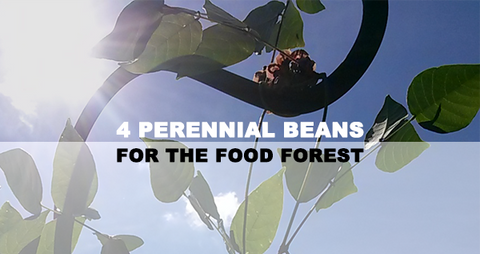
Harvesting atmospheric nitrogen is one of the keys to repairing degraded soil. Perennial beans can be helpful in that regard but can also overtake other elements in poorly planned designs. Careful planning, and a clear understanding of your own goals, is important when introducing any element – especially one as resilient as a good nitrogen fixing plant.
Here I will introduce three perennial beans that can be planted and maintained as permanent, regenerative elements for your Permaculture landscape. Each bean has benefits and limitations, and each fits into a slightly different niche.
Apios americana
Common names: potato bean, hopniss, Indian potato, hodoimo, America-hodoimo, American groundnut, groundnut
Range
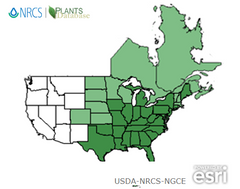
Description/Cultivation
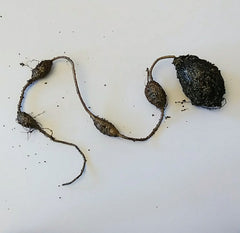 Apios americana is a climbing vine that is primarily grown for its edible rhizomes. Rhizomes, which grow in strings, serve as the most reliable method of propagation, yielding a very high success rate for transplants. Root nodes will self-propagate in the topsoil by sending out additional roots which fatten into new nodes from which additional vines can grow.
Apios americana is a climbing vine that is primarily grown for its edible rhizomes. Rhizomes, which grow in strings, serve as the most reliable method of propagation, yielding a very high success rate for transplants. Root nodes will self-propagate in the topsoil by sending out additional roots which fatten into new nodes from which additional vines can grow.
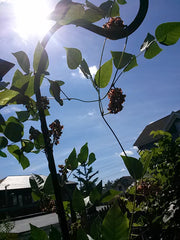 Apios americana grows well in full sun to part shade. The groundnut vine is best grown on a sturdy, trellis-like structure or as a companion to plants like Jerusalem Artichokes, which also must be harvested below ground. While vines are not heavy, they can grow quite thick. Also, mixing groundnuts with supporting perennials is not always a good idea if you intend to harvest your crop, because harvesting the tubers necessarily requires disturbing the soil.
Apios americana grows well in full sun to part shade. The groundnut vine is best grown on a sturdy, trellis-like structure or as a companion to plants like Jerusalem Artichokes, which also must be harvested below ground. While vines are not heavy, they can grow quite thick. Also, mixing groundnuts with supporting perennials is not always a good idea if you intend to harvest your crop, because harvesting the tubers necessarily requires disturbing the soil.
In sunny spaces, where there is little competition from other vining plants, groundnuts can become rampant and opportunistic. The easiest harvests are from large pots which can be spilled out and collected during dormancy, from fall to spring.
Much work was done during the 20th century, to improve the size of and quantity tubers, most notably by William Blackmon of Louisiana State University. While some varieties were developed to mature in one season, most continue to be harvested after two years, when the larger varieties can grow to the size of potatoes. Wild varieties rarely grow more than a couple of inches long.
Edibility
Groundnut tubers are high in protein and can, over time, grow quite large, depending on the variety. The flavor of the tubers is mild, like potatoes, but the flesh is quite dry and can be stringy, depending on age and when they are harvested. For this reason, groundnuts are often cooked with fats or stewed in broth. Tubers must be cooked before eating because they contain latex, which breaks down during the cooking process.
Beans are small but, reportedly, edible. Some strains yield very few beans at all. As a food crop, they have never gained the attention of the roots.
Phaseolus polystachios
Common names: North American wild kidney bean, thicket bean, bean-vine, climbing pea
Range
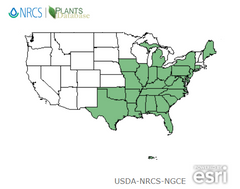
Description/Cultivation
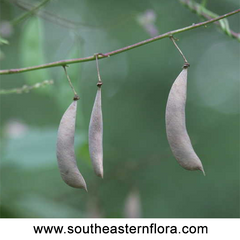 The wild kidney bean is the only species of Phaseolus native to temperate regions of North America[i]. Most closely related to the lima bean, it prefers sun but may grow in part shade. Like the groundnut, vines have a climbing tendency, but cling by twining rather than with tendrils. Pods contain 4 to 6 seeds[ii] 4-8mm long by 3-5mm wide[iii] and will shatter when ripe, dispersing seeds several feet from the parent plant. Beans, therefore, should be collected at maturity but before drying on the vine.
The wild kidney bean is the only species of Phaseolus native to temperate regions of North America[i]. Most closely related to the lima bean, it prefers sun but may grow in part shade. Like the groundnut, vines have a climbing tendency, but cling by twining rather than with tendrils. Pods contain 4 to 6 seeds[ii] 4-8mm long by 3-5mm wide[iii] and will shatter when ripe, dispersing seeds several feet from the parent plant. Beans, therefore, should be collected at maturity but before drying on the vine.
Edibility
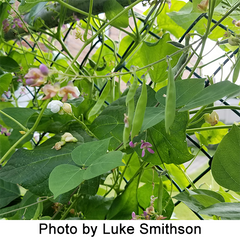 The wild kidney bean is most often used as a dry bean in soups or chilis. Pods are too fibrous to be enjoyed, and flowers are bitter in flavor.[iv]
The wild kidney bean is most often used as a dry bean in soups or chilis. Pods are too fibrous to be enjoyed, and flowers are bitter in flavor.[iv]
Phaseolus coccineus
Common name: Scarlett Runner
Range
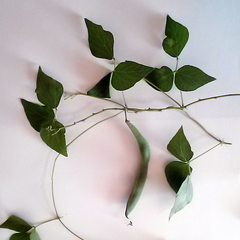 The scarlet runner bean is not native to the United States. It can be grown as a short-lived perennial in warmer climates (USDA Hardiness Zones 7-11). Roots can be brought inside for the winter in colder climates or grown reliably from saved seed.
The scarlet runner bean is not native to the United States. It can be grown as a short-lived perennial in warmer climates (USDA Hardiness Zones 7-11). Roots can be brought inside for the winter in colder climates or grown reliably from saved seed.
Description/Cultivation
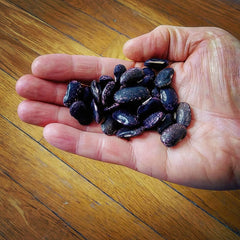 Scarlet runner beans are a favorite in Permaculture circles and can provide generous quantities of beans in a small space. Vines have a twining habit and prefer partial shade for best production. Beans grow in large pods, with up to 10 seeds per pod. These vines love sunlight, but excessive summer heat can slow or stop germination. If possible, provide good airflow and consider allowing the plants some shade during the hottest hours of the day.
Scarlet runner beans are a favorite in Permaculture circles and can provide generous quantities of beans in a small space. Vines have a twining habit and prefer partial shade for best production. Beans grow in large pods, with up to 10 seeds per pod. These vines love sunlight, but excessive summer heat can slow or stop germination. If possible, provide good airflow and consider allowing the plants some shade during the hottest hours of the day.
The beans are up to an inch long, usually with two-tone, variegated colors including brown, red, purple or tan. Seeds grow in pods with up to 10 seeds per pod. Removing young pods can, reportedly, encourage more flowering.
Edibility
The beans can be eaten either young, as green beans, or as dry beans for soups.
Amphicarpaea bracteata
Common names: Hog Peanut
Range
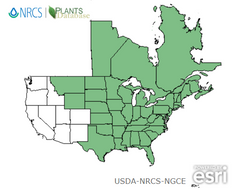
Description/Cultivation
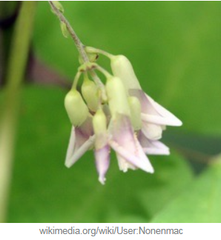 The hog peanut can grow in full sun or full shade as a low vine or even as a groundcover. It can be opportunistic and, thus, should be planted with careful consideration to avoid overrunning your garden. The vine produces beans both from above ground pods and below ground, as solitary beans. Because this bean is more prolific in vine than in bean, it may be less attractive as an edible than as a shade-tolerant, nitrogen fixing groundcover.
The hog peanut can grow in full sun or full shade as a low vine or even as a groundcover. It can be opportunistic and, thus, should be planted with careful consideration to avoid overrunning your garden. The vine produces beans both from above ground pods and below ground, as solitary beans. Because this bean is more prolific in vine than in bean, it may be less attractive as an edible than as a shade-tolerant, nitrogen fixing groundcover.
Edibility
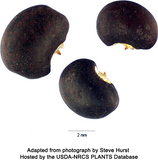 Above ground beans can be dried and eaten like lentils. Below ground beans, while challenging to collect, are considered a choice edible and can even be eaten raw. These legumes are difficult to collect in large enough amounts to contribute meaningfully to a family diet.
Above ground beans can be dried and eaten like lentils. Below ground beans, while challenging to collect, are considered a choice edible and can even be eaten raw. These legumes are difficult to collect in large enough amounts to contribute meaningfully to a family diet.
[i] Retrieved from https://www.ars.usda.gov/research/publications/publication/?seqNo115=331058
[ii] Robyn J. Burnham, Censusing Lianas In Mesic Biomes of Eastern Regions, http://climbers.lsa.umich.edu/?p=3077
[iii] Allard, H. (1947). The ecology of the wild kidney bean Phaseolus polystachios (L.) BSP. Journal of the Washington Academy of Sciences, 37(9), 306-309. Retrieved from http://www.jstor.org/stable/24531921
[iv] Luke Smithson, The North American Wild Kidney Bean, Phaseolus polystachios, retrieved from https://cryofthebolete.com/2018/10/21/the-north-american-wild-kidney-bean-phaseolus-polystachios/


